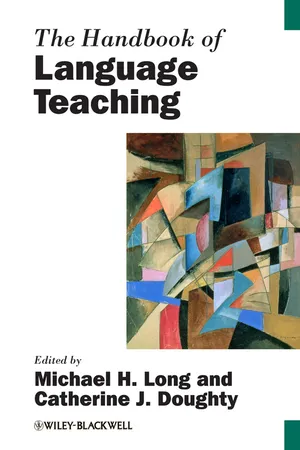Languages & Linguistics
Lenneberg
Lenneberg, in the field of linguistics, is known for his critical period hypothesis, which suggests that there is a specific window of time during childhood when language acquisition must occur in order for a person to achieve native-like fluency. This hypothesis has had a significant impact on the study of language acquisition and the understanding of the relationship between age and language learning.
Written by Perlego with AI-assistance
Related key terms
3 Key excerpts on "Lenneberg"
- María del Pilar García Mayo, María Luisa García Lecumberri(Authors)
- 2018(Publication Date)
- Multilingual Matters(Publisher)
Penfield's notion about the 'unphysiological' nature of later language learning was very much echoed in the work of Lenneberg, the person who is generally acknowledged as the 'father' of the Critical Period Hypothesis relative to language acquisition. Lenneberg saw the human capacity for language acquisition as constrained by a critical period beginning at age two and ending around puberty, this period coinciding with the lateralization process – the specialisation of the dominant hemisphere of the brain for language functions. He adduced a wide range of evidence pointing to changes in the brain that were occurring during this period. However, his claim that lateralisation ends at puberty has been significantly undermined by later studies which reinterpret the data in question as indicating that the process is already complete in early childhood (see, e.g., Kinsbourne & Hiscock, 1977; Krashen, 1973). Moreover, that part of Lenneberg's argument which referred to L2 learning, namely his suggestion that after puberty the learning of L2s required 'labored effort' and foreign accents could not be 'overcome easily' (Lenneberg, 1967: 176) was of dubious status in scientific terms. While his arguments in relation to the maturation of the brain development were supported with a range of neurological evidence (some of which has, as has been noted, since been reinterpreted), no evidence was offered in respect of his claims regarding post-pubertal L2 learning, which relied instead simply on an implicit appeal to popular assumptions.The Concept of Critical Period
Before we proceed further in our discussion of the Critical Period Hypothesis (henceforth CPH), it may be worth reminding ourselves how the concept of critical period is usually understood in the biological sciences. The example that is usually cited in this connection is that provided by Lorenz (1958), who noted that new-born goslings became irreversibly attached to the first moving object they perceived after hatching. Usually, the first moving object in question is the gosling's mother. However, any other moving object will trigger the relevant reaction if it comes into the gosling's line of vision in the post-hatching period. The period during which the attachment of this kind may be effected is limited in duration, and beyond that period the gosling will no longer fix its following behaviour in the way described. Indeed, when this particular period ends, goslings will retreat from rather than follow moving objects.- eBook - ePub
The Psychology of Language
From Data to Theory
- Trevor A. Harley(Author)
- 2013(Publication Date)
- Psychology Press(Publisher)
The critical period hypothesis of Lenneberg (1967) comprises two related ideas. The first idea is that certain biological events related to language development can only happen in an early critical period. In particular, hemispheric specialization takes place during the critical period, and during this time children possess a degree of flexibility that is lost when the critical period ends. The second component of the critical period hypothesis is that certain linguistic events must happen to the child during this period for development to proceed normally. Proponents of this hypothesis argue that language is acquired most efficiently during the critical period. The idea of a critical period for the development of particular processes is not unique to humans. Songbirds display hemispheric specialization in that only one hemisphere controls singing (Demers, 1988). Many birds such as the chaffinch are born with the rudiments of a song, but must be exposed to the male song of their species between the ages of 10 and 15 days in order to acquire it normally. Evidence for a critical period for human linguistic development comes from many sources. Many songbirds, such as the chaffinch, are born with the rudiments of a song, but must be exposed to the male song of their species between the ages of 10 and 15 days in order to acquire it normally. Evidence from the development of lateralization The structure of the brain is not completely fixed at birth. A considerable amount of development continues after birth and throughout childhood (and indeed perhaps in adolescence); this process of development is called maturation. Furthermore, the brain (primarily the cortex) shows some degree of plasticity, in the sense that after damage it can to some extent recover and reorganize, or can adapt in response to pronounced changes in input, even in adulthood - eBook - ePub
- Michael H. Long, Catherine J. Doughty(Authors)
- 2011(Publication Date)
- Wiley-Blackwell(Publisher)
Part III Psycholinguistic Underpinnings of Language LearningPassage contains an image
Chapter 5 The Language-Learning Brain
ALAN BERETTAIn second language learning and teaching, there seem to be two principal ways in which neurolinguistics is of interest: as a source of evidence to support a particular approach to SLA, usually via the critical period issue; and as a source of evidence to promote some supposedly “brain-compatible” classroom teaching technique and to dismiss other techniques that fail on this criterion. The latter use of language-brain research is, to say the least, premature. Even the neuroimaging work on the critical period issue appears to entertain higher expectations than can reasonably be sustained in view of the uncontroversial fact that far less complex problems in language-brain research remain to be solved. This chapter attempts to provide a more realistic perspective.In an attempt to anchor debate to reality, the question that first needs to be considered is what the enterprise of neurolinguistics could possibly be. After all, there is nothing obvious about what is meant by grafting linguistics onto neuro. Once this question is confronted, the answer that it yields may serve as a basis for judging what claims are warranted and what expectations might reasonably be entertained with respect to brains and second language teaching and learning.What is Neurolinguistics?
Someone wishing to find out what neurolinguistics is might turn to the Linguistic Society of America’s website (www.lsa.org), as it contains sketches of the various sub-disciplines of linguistics. Here is what it says about neurolinguistics
Learn about this page
Index pages curate the most relevant extracts from our library of academic textbooks. They’ve been created using an in-house natural language model (NLM), each adding context and meaning to key research topics.


